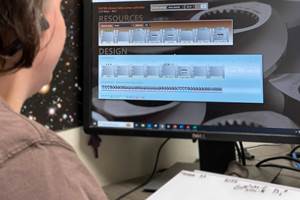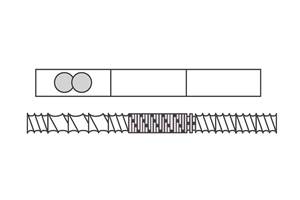K 2010 Preview, Compounding ‘Slower’ Compounders Suggest Trend Toward Energy-Efficient Designs
channel depth in larger machines, which exposes the material to less mechanical stress at comparable residence times.
channel depth in larger machines, which exposes the material to less mechanical stress at comparable residence times. Moreover, the combination of medium speeds and increased channel depths are said to substantially reduce screw and barrel wear. The company has optimized the extruder power train and heating system to further increase energy efficiency.
KM Berstorff also will introduce the EasyClean compounding line designed to reduce cleaning and changeover times by up to 40%. The design features clamp joints and clamped flange connections at the feed hoppers and the material conduits to the metering devices and the silos that can be loosened without tools.
The docking station for the bulk-solids metering device was also engineered to speed up product changeovers: During a change, the second metering device can be cleaned off-line.
The line at the show will be a ZZE 60-mm twin-screw equipped with a Mixomat—a device that combines conveying, weighing, and mixing functions in a single unit. This cost-effective system reduces the number of metering devices required for frequent compound changes involving different pellet types. A large cleaning opening allows quick cleanout when material or color is changed.
The Mini-Compounder KETSE 12/36, from Brabender (cwbrabender.com) is a 12-mm, 36:1 L/D twin-screw machine for product development and lab applications. The clamshell barrel opens to allow visual assessment of individual processing steps. Metering and venting ports can be located at 0 D, 6 D, 12 D and 26 D. Side feeding can be installed at 14 D. Brabender also offers this machine in a 20-mm, 40:1 L/D configuration.
HIGH-OUTPUT PELLETIZING
For high-capacity polyolefin production, Coperion (coperion.com) will display the UG 1.250, said to be the largest underwater pelletizer in the world. It enables throughputs in excess of 100 tons/hr for polyethylene. The first UG 1.250 will go into operation soon. A slightly smaller but similarly constructed UG 925 for polypropylene has been in operation since the middle of 2009.
Coperion is also offering an exceptionally large underwater pelletizer for TPE. The UG 750, which will be installed at the beginning of 2011, was designed to account for the stickiness typical of TPE pellets. Axial water flow along the knife shaft into the cutting chamber, and radial water flow along the pelletizing knives towards the water chamber exit, minimize turbulence in the cutting chamber. This results in fewer collisions between the freshly cut, tacky pellets, which prevents agglomeration.
Coperion will be introducing a new size melt pump. Model MP 450 can handle 30 to 50 tons/hr of PP and 40 to 50 tons/hr of PE. The pumps have single or twin shaft drive options.
Gala Industries (gala-industries.com) will show introduce its Model EAC (Electronically Adjusted) pelletizer for production rates up to 33,000 lb/hr. The pelletizer offers fully automated control of blade adjustment and positioning for maximum blade and die life. Monitoring and adjustment are programmed in the PLC controller. An integrated blade-position measuring system alerts the operator when a blade change is needed.Not too long ago, high-speed, high-torque twin-screw compounders were all the rage. They operated at blazing speeds up to 1800 rpm and required high drive power. At K 2010, KraussMaffei Berstorff (berstorff.com) is dialing back a bit, presenting a ZE 60 A UTX twin-screw with max. speed of 600 rpm and design features that enhance energy efficiency. KM Berstorff has conducted tests revealing that substantial energy savings and quality enhancements can be achieved in many applications if larger extruders are operated at medium speeds instead of using smaller machines at high speeds.
Related Content
Program Helps Compounders Configure Screw, Barrel Layout
New software from ENTEK is said to make it easier for compounders to design their own screw and barrel configurations.
Read MoreStrategically Manage Pressure to Help Ensure Quality in Co-Rotating Twin-Screw Extrusion
Pressure measurement provides an invaluable window into any extrusion process, but it must also be strategically managed at every stage of the process to ensure a quality part is being extruded.
Read MoreTwin-Screw Showcased in Circular Economy Demo
NPE2024: A KraussMaffei twin will upcycle pelletized blood vials, which will then be overmolded on another press to produce bottle openers.
Read MoreConfiguring the Twin Screw Extruder: Part 4
For many compounding operations, material is fed to the extruder at the feed throat. This is the case when feeding a single polymer or a blend of polymers mixed with solid additives. Some ingredients, however, present a challenge in feeding. Here’s how to solve to them.
Read MoreRead Next
People 4.0 – How to Get Buy-In from Your Staff for Industry 4.0 Systems
Implementing a production monitoring system as the foundation of a ‘smart factory’ is about integrating people with new technology as much as it is about integrating machines and computers. Here are tips from a company that has gone through the process.
Read MoreFor PLASTICS' CEO Seaholm, NPE to Shine Light on Sustainability Successes
With advocacy, communication and sustainability as three main pillars, Seaholm leads a trade association to NPE that ‘is more active today than we have ever been.’
Read MoreBeyond Prototypes: 8 Ways the Plastics Industry Is Using 3D Printing
Plastics processors are finding applications for 3D printing around the plant and across the supply chain. Here are 8 examples to look for at NPE2024.
Read More












